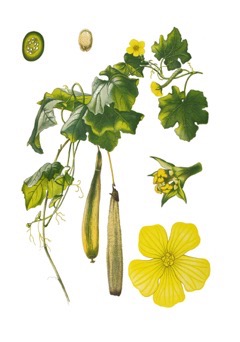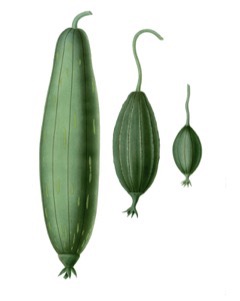 |
|
http://www.edibleplants.org |
 |
| http://www.edibleplants.org |
Translate this page:
Summary
Luffa aegyptiaca or commonly known as Loofah is an annual vine popular for its fruits. It is native to South and Southeast Asia. The flowers are yellow. The fruits are about 30 cm long resembling a cucumber. The fruits are edible when young but become highly fibrous and inedible as they mature. However, such characteristics of mature fruits make it ideal to use as a scrubbing sponge. Young shoots, leaves, flower bugs, and seed are edible as well. The seed also yields edible oil. Further, loofah exhibits medicinal properties as well. It controls bleeding, improves circulation, and promotes healing. The fruit, in particular, is used in the treatment of various conditions such as rheumatism, chest pains, back pains, orchitis, hemorrhoids, internal bleeding, and insufficient lactation.
Physical Characteristics

 Luffa is an evergreen Annual Climber growing to 15 m (49ft) by 0.5 m (1ft 8in) at a fast rate.
Luffa is an evergreen Annual Climber growing to 15 m (49ft) by 0.5 m (1ft 8in) at a fast rate.
See above for USDA hardiness. It is hardy to UK zone 10. The flowers are pollinated by Insects.
Suitable for: light (sandy), medium (loamy) and heavy (clay) soils, prefers well-drained soil and can grow in nutritionally poor soil. Suitable pH: mildly acid, neutral and basic (mildly alkaline) soils and can grow in very acid and very alkaline soils.
It cannot grow in the shade. It prefers moist soil.
UK Hardiness Map
US Hardiness Map
Synonyms
Cucumis fricatorius Sessé & Moc. Luffa acutangula subangulata (Miq.) Cogn. Luffa cylindrica (L.) T.D
Plant Habitats
Edible Uses
Fruit - raw or cooked[418 ]. Young fruits can be eaten in salads like cucumber[301 ]. They are also used in soups, curries etc[300 , 301 ]. The fruit is best picked young, when about 10cm long, and used like courgettes[296 ]. Older fruits become fibrous and are bitter and inedible[300 , 418 ]. Young shoots, leaves and flower buds - cooked. Steamed and served with rice[301 ]. Used in stir-fries[296 ]. Seed - roasted, salted and eaten as a delicacy[301 ]. A cooking oil is obtained from the seed[301 , 418 ].
References More on Edible Uses
Medicinal Uses
Plants For A Future can not take any responsibility for any adverse effects from the use of plants. Always seek advice from a professional before using a plant medicinally.
The loofah is an astringent, pain-killing herb that controls bleeding, promotes healing, improves circulation and milk flow[238. It acts mainly on the lungs, liver and stomach[238 ]. The fruits are used internally in the treatment of rheumatism, chest pains, backache, orchitis, haemorrhoids, internal bleeding and insufficient lactation[238 ]. Externally, it is applied to shingles and boils[238 ]. The dried fruits are used as abrasive sponges in skin care to remove dead skin and stimulate the peripheral circulation[238 ].
References More on Medicinal Uses
The Bookshop: Edible Plant Books
Our Latest books on Perennial Plants For Food Forests and Permaculture Gardens in paperback or digital formats.

Edible Tropical Plants
Food Forest Plants for Hotter Conditions: 250+ Plants For Tropical Food Forests & Permaculture Gardens.
More

Edible Temperate Plants
Plants for Your Food Forest: 500 Plants for Temperate Food Forests & Permaculture Gardens.
More

More Books
PFAF have eight books available in paperback and digital formats. Browse the shop for more information.
Shop Now
Other Uses
Other Uses The mature fruit is dried and the fibrous remains used as a skin brush for washing[296 ]. The sponges are prepared by steeping the mature fruit in running water until the skin and seed contents have been washed away[200 ]. The dried fruit is also used to make items such as scrubbing pads to clean plates, pots etc; filters; table mats; insoles; sponges; sandals; shock-absorbing materials; and gloves[418 , 521 ].
Special Uses
References More on Other Uses
Cultivation details
A plant of the lowland tropics, where it is found at elevations up to 1,000 metres. It can also be grown in subtropical and temperate areas so long as there is a growing season of 4 months or more[418 ]. It grows best in areas where annual daytime temperatures are within the range 23 - 27°c, but can tolerate 10 - 38°c[418 ]. It prefers a mean annual rainfall in the range 1,200 - 2,000mm, but tolerates 300 - 3,000mm[418 ]. Yields can be reduced in areas of heavy rain[300 ]. Prefers a position in full sun[238 ]. Plants succeed in poor soils, but fruit best in soils of moderate fertility[296 ]. Plants are most productive when grown in well-drained soils with a high content of organic matter[300 ]. Prefers a pH in the range 5.5 - 6.5, tolerating 4.3 - 8.3[418 ]. Plants can produce their first crop of immature fruits within 2 months from seed[296 ]. Mature fruits take 3 - 4 months to ripen[418 ]. Yields of up to 30 - 40 tonnes per hectare, or 20 - 25 fruits per plant, have been recorded[418 ]. Hand pollination of female flowers in the morning can increase yields[300 ]. There are some named varieties[300 , 301 ].
References Carbon Farming Information and Carbon Sequestration Information
Temperature Converter
Type a value in the Celsius field to convert the value to Fahrenheit:
Fahrenheit:
The PFAF Bookshop
Plants For A Future have a number of books available in paperback and digital form. Book titles include Edible Plants, Edible Perennials, Edible Trees,Edible Shrubs, Woodland Gardening, and Temperate Food Forest Plants. Our new book is Food Forest Plants For Hotter Conditions (Tropical and Sub-Tropical).
Shop Now
Plant Propagation
Seed - can be sown in situ or in containers[300 ]. When sowing in containers, place 2 - 3 seeds in each container, thinning to the best plant once they have germinated. Keep the plants growing quickly and plant out once they are 15cm or more tall.
Other Names
If available other names are mentioned here
Loofah
Native Range
Coming Soon
Weed Potential
Right plant wrong place. We are currently updating this section.
Please note that a plant may be invasive in one area but may not in your area so it's worth checking.
Conservation Status
IUCN Red List of Threatened Plants Status : This taxon has not yet been assessed

Growth: S = slow M = medium F = fast. Soil: L = light (sandy) M = medium H = heavy (clay). pH: A = acid N = neutral B = basic (alkaline). Shade: F = full shade S = semi-shade N = no shade. Moisture: D = dry M = Moist We = wet Wa = water.
Now available:
Food Forest Plants for Mediterranean Conditions
350+ Perennial Plants For Mediterranean and Drier Food Forests and Permaculture Gardens.
[Paperback and eBook]
This is the third in Plants For A Future's series of plant guides for food forests tailored to
specific climate zones. Following volumes on temperate and tropical ecosystems, this book focuses
on species suited to Mediterranean conditions—regions with hot, dry summers and cool, wet winters,
often facing the added challenge of climate change.
Read More
Expert comment
Author
Mill.
Botanical References
Links / References
For a list of references used on this page please go here
A special thanks to Ken Fern for some of the information used on this page.
Readers comment
| Add a comment |
|
If you have important information about this plant that may help other users please add a comment or link below. Only comments or links that are felt to be directly relevant to a plant will be included. If you think a comment/link or information contained on this page is inaccurate or misleading we would welcome your feedback at [email protected]. If you have questions about a plant please use the Forum on this website as we do not have the resources to answer questions ourselves.
* Please note: the comments by website users are not necessarily those held by PFAF and may give misleading or inaccurate information.
To leave a comment please Register or login here All comments need to be approved so will not appear immediately.
|
|